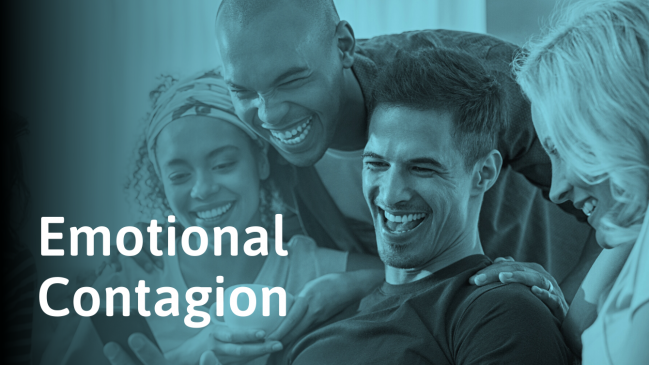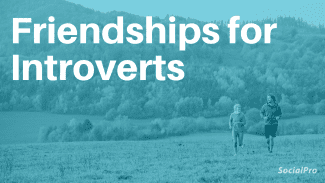If you’ve ever found yourself “catching” someone else’s bad mood or found yourself smiling at a friend’s obvious good mood, you’ve experienced something known in psychology as emotional contagion.
In this article, we’re going to look at what emotional contagion is, how it happens, and how taking steps to manage emotional contagion can help you feel generally happier.
- What is emotional contagion?
- How to manage emotional contagion
- What causes emotional contagion?
- Emotional contagion on social media
- The upsides of emotional contagion
- Common questions
What is emotional contagion?
Emotional contagion is the way you can become “infected” by someone else’s feelings. Their good mood might spread to you, making you more cheerful. Alternatively, you could “catch” their bad mood. Emotional contagion is closely related to empathy, but not all empathy leads to emotional contagion.[1]
Some people are naturally more susceptible to emotional contagion than others, and there are several tests that psychologists are currently using to measure just how vulnerable a person is to other people’s emotions.[2]
Emotional contagion is strongest when we’re talking face-to-face, but you can pick up emotions from movies, music, social media such as Facebook and Instagram, or even a good book.[3]
Emotional contagion can be a positive experience, but when it leads you to feel other people’s negative emotions can become “toxic empathy.”
How to manage emotional contagion
Using your understanding of emotional contagion to help you deal well with people is about minimizing how much of other people’s negativity you catch and maximizing the amount of their positivity you are exposed to. You can also think about trying to make your own positivity contagious.
Here are some important tips for trying to make emotional contagion work to your benefit.
1. Be aware of which emotions are yours
It might seem obvious, but try to understand which emotions came from your experience and which you are picking up from others’ reactions. Even though this sounds straightforward, it can be tricky.
Look for times when you have a sudden change in mood. Ask yourself what triggered the change. Did something change in your environment, or could you be picking up someone else’s feelings?
See whether someone else is feeling the same way you are right now. If you’re suddenly happy when everyone else is sad, it’s probably not emotional contagion. If you’re sitting with a friend who’s depressed and you start to feel sad, it most likely is.
Another sign that you’re experiencing emotional contagion is using someone else’s phrases in your internal monologue. If your friend is talking about how “everything’s pointless,” and you then find yourself thinking that something is “pointless” when you wouldn’t normally use that word, ask where that thought came from. The emotion you’re experiencing might also have come from them.
2. Set emotional boundaries
Once you are aware that someone’s emotions are influencing your emotional state, try to set personal boundaries. It’s not that you don’t want their emotional state to influence you at all, but you need to control how much they influence you and in what way.
For example, if a close friend comes to tell you good news, you want to absorb their enthusiasm and joy. Trying to stop yourself from sharing this would mean that you miss out on a lovely feeling and might damage your relationship with your friend if they feel rejected.
On the other hand, if your friend is depressed, you probably don’t want all of the feelings associated with that to transfer onto you. You might be ok with feeling sad for them, but it won’t help either of you if you start feeling as hopeless and exhausted as they do.
There are lots of different ways to set emotional boundaries and control emotional contagion. You may need to experiment to find out which ones work well for you and which ones don’t. Here‘s a list of examples of ways to set an emotional boundary
- Creating an internal monologue to remind you that this isn’t your feeling. Try saying to yourself, “This feeling isn’t mine. It belongs to … I can be aware of it without feeling it.”
- Visualizing a barrier or protective field to protect you from negative feelings.
- Changing your inner monologue to sound like your friend when thinking about “their” emotions. Try using words and phrases that they often use.
- Setting a time limit for how long you engage with their strong emotions, then try changing the subject.
- Journaling after seeing the person can help you separate your emotions from theirs.
- Meditating daily to help you get more in touch with your own feelings.
- Having a shower or changing your clothes to help you “reset” yourself. Imagine washing off the extra emotions.
- Leaning into your original emotions. If you are happy, focus on why you’re happy. You’re not trying to push away negative emotions. You’re trying to make your authentic emotions stronger.
3. Create physical boundaries
Physical boundaries can help to prevent emotional contagion as well. Some organizations have started creating quieter, more private areas in the workplace for introverts or employees who are particularly susceptible to emotional contagion to work in.[4]
Technology can help to limit emotional contagion. You are more likely to pick up a colleague’s emotions during a face-to-face meeting than over a Zoom call, for example. This is probably because we don’t pick up as many details of the other person’s facial feedback during video calls.
Good physical boundaries to prevent emotional contagion limit sound. Not being able to hear the small sighs and changes in breathing patterns can help you to keep others’ emotions from affecting you as much.
Having a physical barrier isn’t always enough, as anyone who has gone into another room during an argument can attest. Very strong feelings from another person can seem to follow us, even through closed doors and noise-canceling headphones. Even if it can’t prevent emotional contagion, it can help to give you the space to separate your emotions from the other person’s.
4. Talk about the issue directly
Usually, people who are spreading their emotions aren’t aware of it. They’re just having strong feelings without realizing that others might notice, let alone actually pick up those feelings themselves.
If someone else’s negative emotions are putting a dampener on your feelings, try talking to them about it. Have an honest conversation about what’s going on and the way that it is affecting you (and potentially others if you’re in a shared space such as in a co-living arrangement or an office).
Try to avoid starting the conversation with blame. Acknowledge that they’re going through a difficult time and explain that you do care but that you need to look after your own wellbeing as well.
5. Remember that you share your emotions too
Emotional contagion isn’t just something you receive. You’re also passing your feelings on to others. Being aware of this, and thinking about how your energy affects a group, can help you be a good friend.
Although we broadcast our emotions unconsciously, you can make a bigger impact by actively sharing your happiness with the people you care about. Try telling people your good news, smiling when you’re happy, and talking about things that cheer you up.
If you’re going through a tough time, try to be aware of your emotional contagion. This doesn’t mean that you shouldn’t talk to others about your problems. In fact, it means the opposite. Talking about how you’re feeling helps other people understand what you’re going through and makes it easier for them to separate your feelings from their own.
6. Limit or remove sources of negativity
Once you understand how emotional contagion works, you can try to remove unnecessary sources of negativity from your daily life. Lots of people find that muting very negative people on social media helps to improve their overall happiness.
You can also get emotional contagion from people you don’t know or even fictional characters. Some people find that they can get emotional contagion from horror films or even the news. It’s OK to turn off the TV or put down your phone to avoid catching someone else’s emotions.
What causes emotional contagion?
When you first think about emotional contagion, it might seem a little unscientific. After all, we understand how diseases spread through epidemiology, but it’s hard to see a scientific basis for how emotions might spread. In fact, emotional contagion is firmly rooted in our physiology.[5]
When we spend time with other people, we often subconsciously start to mimic some of their body language, such as their facial expressions or postures. You might sometimes also notice yourself adopting some of their speech patterns or favorite phrases.
Sometimes you will mimic something noticeable. For example, two people walking together will normally start to take their steps at the same time.[6] Most of the things you might mimic will be small and very difficult to notice, such as a little bit of tension in your neck muscles or changes in your breathing pattern.
This mimicry is the mechanism underlying empathy and is a key part of the communication process. When we mimic someone else’s body language, we start to feel some of the emotions they’re feeling.[7] This is because the relationship between body language and feelings goes both ways. Being happy might make you smile, but smiling can also help you to feel happier.
If you spend enough time with someone, you can feel their emotions very strongly. Because we often don’t realize that we’ve been mimicking them and picking up their feelings, we assume that the way we are feeling is coming from our own experiences. You might even find yourself rationalizing or justifying those feelings. After spending time with someone who is depressed, for example, you might find yourself thinking about all the negative things in your life.
Emotional contagion on social media
Although most of our emotional contagion comes from face-to-face interactions, we can still pick up other people’s emotions through online and social media interactions. But how can we mimic someone if we can’t see them?
It turns out that we make many of the same facial expressions and body language changes when we read emotional social media posts as we would if we’re actually talking to someone.[8]
For example, we still smile when we read someone’s good news on Snapchat or tense our shoulder and neck muscles when we hear through Twitter that someone we care about has had a stressful experience.
Although social media might lead to less emotional contagion from a single person, you might notice that there are often trends. Bad international news can leave your entire feed looking pretty bleak, whilst an expectedly sunny day can prompt hundreds of upbeat posts.
One study (with questionable ethics) found that increasing the proportion of negative posts in people’s Facebook feeds increased how many negative posts they made themselves.[9] Similarly, seeing more positive posts in their news feed increased how many positive posts they made. If you are absorbing the same emotion from lots of different people in your feed, there’s a good chance you might catch that emotion.
Are there any upsides to emotional contagion?
Emotional contagion can be a wonderful thing. It’s one of the reasons we feel elated at a concert or experience the camaraderie of supporting a sports team.
If we surround ourselves with positive, upbeat, kind people, we will often find that our moods and mindset move to be more like theirs. We might find that our internal monologue has more positive words and that we are less prone to self-doubt or depression.
There is a difference, however, between being a generally happy and optimistic person and toxic positivity. People who don’t make space for you to be sad or who tell you to “look on the bright side” of even very serious problems probably won’t trigger emotional contagion. They’ll just leave you feeling more isolated and alone because they refuse to acknowledge the importance of the challenges you’re facing.
You’ll find the most emotional contagion with people you have the strongest bonds with.[10] The best way to get the most out of emotional contagion is to build a friendship group of people you trust and who are positive and supportive.
Common questions
Are some people more susceptible to emotional contagion?
There is huge variation in susceptibility to emotional contagion.[11] People who are very susceptible to emotional contagion are sometimes called empaths. Women are typically more susceptible overall, as are people with some conditions such as borderline personality disorder.[12][13]
What feeling is the most emotionally contagious?
Research into emotional contagion is relatively new, so it’s not completely clear which types of emotion are most contagious. It seems that we are more likely to “catch” negative emotions from others, but we don’t have strong evidence for this.[14]
Why do I mirror others’ emotions?
Mirroring other people’s emotions can be a sign that you have high levels of empathy. You may be subconsciously adopting some of their body language or behaviors, which can influence your emotions. Specific cells in your brain known as mirror neurons may influence how much you empathize with others.[15]
Is crying contagious?
Feeling tearful when other people are crying is completely normal. Studies show that even newborns cry more when they hear others crying.[16] This seems to peak at about age 30.[17] Some people are more affected than others, and you may be more likely to catch crying from someone you’re close to.
Are some people emotional ‘superspreaders’?
Just as some people find it easier to catch other people’s emotions, some people have high transmissibility.[18] If someone who is naturally a powerful transmitter of emotions experiences particularly strong feelings, they may become an emotional superspreader.
Why do I catch some people’s emotions more easily than others?
You are more susceptible to emotional contagion from people you feel connected to, such as close friends.[19] Alternatively, you might have something in common, such as looking alike or being on the same team.[20] People who respond strongly to emotions may also spread them more effectively.



